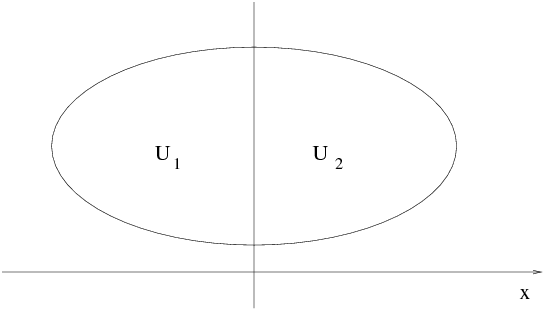the following problem:
probpfppgreen
Problem: Problem ) : Find such that:
with .
Let us find the solution using the Green method. Several cases exist:
Nucleus zero, homogeneous problem
defgreen
Definition: The Green solution\index{Green solution} of problem is the function solution of:
eqdefgydy
The Green solution of the adjoint problem is the function solution of
eqdefgydyc
where horizontal bar represents complex conjugation.
theogreen
Theorem: If and exist then
Proof:
By definition of the adjoint operator of an operator
Using equations eqdefgydy and eqdefgydyc of definition defgreen for and , one achieves the proof of the result.
In particular, if then .
Theorem:
There exists a unique function such that
is solution of Problem and
The proof[1] of this result is not given here but note that if exists then:
Thus, by the definition of the adjoint operator of an operator :
Using equality , we obtain:
and from theorem theogreen we have:
This last equation allows to find the solution of boundary problem, for any function , once Green function is known.
Kernel zero, non homogeneous problem
Solution of problem is derived from previous Green functions:
Using Green's theorem, one has:
Using boundary conditions and theorem theogreen, we get:
This last equation allows to find the solution of problem , for any triplet , once Green function is known.
Non zero kernel, homogeneous problem
Let's recall the result of section secchoixesp :
Theorem:
If has non zero solutions, and if isn't in the orthogonal of , the problem has no solution.
Proof:
Let such that . Let be a solution of ({\it i.e} a function of ). Then:
Thus
However, once is projected onto the orthogonal of , calculations similar to the previous ones can be made: Let us assume that the kernel of is spanned by a function and that the kernel of is spanned by .
defgreen2
Definition: The Green solution of problem is the function solution of
The Green solution of adjoint problem is the function solution of
where horizontal bar represents complex conjugaison.
theogreen2
Theorem: If and exist, then
Proof:
By definition of the adjoint of an operator
Using definition relations defgreen2 of and , one obtains the result.
In particular, if then .
Theorem:
There exists a unique function such that
is solution of problem in and
Proof[2] of this theorem is not given here. However, let us justify solution definition formula. Assume that exists. Let be the projection of a function onto .
This can also be written:
or
From theorem theogreen2, we have:
zlxuc olzkyc bjnc oihxc vz8cg
Resolution
secresolinv
Once problem's Green function is found, problem's solution is obtained by simple integration. Using of symmetries allows to simplify seeking of Green's functions.
Images method
secimage
\index{images method}
Let be a domain having a symmetry plan: . Let be the border of . Symmetry plane shares into two subdomains: and (voir la figure figsymet).
figsymet

Let us seek the solution of the folowing problem:
probori
Problem: Find such that:
and
knowing solution of problem
probconnu
Problem: Find such that:
and
Method of solving problem probori by using solution of problem probconnu is called images method ([ma:equad:Dautray1]). Let us set . Function verifies
and
Functions and verify the same equation. Green function is thus simply the restriction of function to . Problem probori is thus solved.
Invariance by translation
When problem is invariant by translation, Green function's definition relation can be simplified. Green function becomes a function that depends only on difference and its definition relation is:
where is the convolution product (see appendix{appendconvoldist})\index{convolution}. Function is in this case called elementary solution and noted . Case where is translation invariant typically corresponds to infinite boundaries ([ma:distr:Schwartz65]).
Here are some examples of well known elementary solutions:
Example:
Laplace f equation in . Considered operator is:
Elementary solution is:
Example:
Helmholtz equation in . Considered operator is:
Elementary solution is: